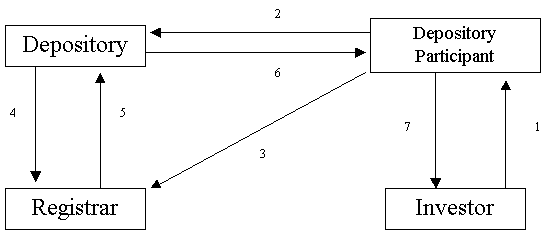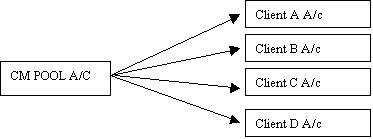DEMAT
Indian investor community has undergone sea changes in the past few
years. India now has a very large investor population and ever increasing
volumes of trades. However, this continuous growth in activities has also
increased problems associated with stock trading. Most of these problems arise
due to the intrinsic nature of paper based trading and settlement, like theft
or loss of share certificates. This system requires handling of huge volumes of
paper leading to increased costs and inefficiencies. Risk exposure of the
investor also increases due to this trading in paper.
Some of these
risks are :
·
Delay in
transfer of shares.
·
Possibility
of forgery on various documents leading to bad deliveries, legal disputes etc.
·
Possibility
of theft of share certificates.
·
Prevalence of
fake certificates in the market.
·
Mutilation or
loss of share certificates in transit.
This has made the
investors as well as broker wary of Indian capital market. In this scenario
dematerialized trading is certainly a welcome move.
What is Dematerialization?
Dematerialization or "Demat" is a process whereby your
securities like shares, debentures etc, are converted into electronic data and
stored in computers by a Depository.
What is a Depository?
Depository functions like a securities bank, where the dematerialized physical securities are traded and held in custody. This facilitates faster and low cost settlement. Depository is much like a bank and perform many activities that are similar to a bank. Following table compares the two.
|
Bank |
Depository |
|
Holds funds in accounts |
Holds securities in account |
|
Transfers funds between accounts |
Transfers securities between accounts |
|
Transfers without handling money |
Transfers without handling securities |
|
Safekeeping of money |
Safekeeping of securities |
NSDL and CDS
At present there are two depositories in India, National Securities
Depository Limited (NSDL) and Central Depository Services (CDS). NSDL is the
first Indian depository, it was inaugurated in November 1996. NSDL was set up
with an initial capital of US$28mn, promoted by Industrial Development Bank of
India (IDBI), Unit Trust of India (UTI) and National Stock Exchange of India
Ltd. (NSEIL). Later, State Bank of India (SBI) also became a shareholder.
The other depository is Central Depository Services (CDS). It is still
in the process of linking with the stock exchanges. It has registered around 20
DPs and has signed up with 40 companies. It had received a certificate of
commencement of business from Sebi on February 8, 1999. In order to facilitate
transfers between investors having accounts in the two existing depositories in
the country the Securities and Exchange Board of India has asked all stock
exchanges to link up with the depositories. The NSDL and CDS have signed an
agreement for inter-depository connectivity.
What is a DP?
NSDL carries out its activities through various functionaries called
business partners who include Depository Participants (DPs)
Who can be a DP?
1.
Public
Financial Institutions
2.
Scheduled
banks
3.
RBI Approved
Foreign banks operating in India
4.
State
Financial Corporations
5.
Institutions
engaged in providing financial services, promoted by any of the institutions
mentioned above either jointly or severally.
6.
Custodians of
securities who are registered with SEBI
7.
Clearing
Corporations or Clearing Houses of Stock Exchanges
8.
Stock Brokers
registered with SEBI
9.
Non Banking
Finance Companies

2.
DP intimates
Depository of the request through the system
3.
DP submits
the certificate with DRF to registrar
4.
Registrar
confirms the Demat from Depository
5.
Registrar
validates the request, updates records & informs the Depository
6.
Depository
credits the DP a/c & informs DP
7.
DP updates
the investor's a/c & informs the investor.
Trading in dematerialized shares results in substantial savings for the investors. Following tables gives an idea about these savings.
Savings for a person who buy shares for long term investment
(On a purchase of Rs10000)
|
Item |
Physical (Rs) |
Depository (demat) (RS) |
Savings (Rs) |
|
Brokerage |
75-100 |
50-75 |
25-50 |
|
*Stamp Duty |
50 |
- |
50 |
|
Postal Charges |
10-30 |
- |
10-30 |
|
Company Objection (courier etc.) |
10-30 |
- |
10-30 |
|
Settlement charges |
- |
5-10 |
-(5-10) |
|
#Custody (5 years) |
- |
10-50 |
-(10-50) |
|
Total |
|
|
35-100 |
* Stamp duty of
0.5%
# Custody charge
of 0.05%- 0.1%
Savings for an
investor who sells dematerialized shares
(For a sale of
Rs10000)
|
Item |
Physical (Rs) |
Depository (demat) (Rs) |
Savings (Rs) |
|
*Brokerage |
75-100 |
50-75 |
25-50 |
|
Company Objection (courier, etc.) |
10-30 |
- |
10-30 |
|
Settlement charges |
- |
-(5-10) |
-(5-10) |
|
Total |
|
|
25-75 |
Sub-Brokers:
Sub-Brokers
have two options:
- Arrange to
deliver the securities directly from the pool account of main broker to
the beneficial owner account of the buying clients.

2. Arrange to
deliver the securities from the pool account of the main broker to beneficial
owner account of the sub-broker kept for trading purpose and then forward the
same to buying client.
CM POOL A/C
